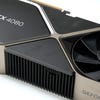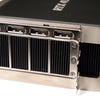Nvidia GeForce RTX 4080 review: a powerful GPU with a big pricing problem
Compared to RTX 3080 and RTX 4090, Nvidia's latest is just too expensive.
There's going to be a lot of criticism aimed at Nvidia's new RTX 4080 but it's important to stress that there is nothing wrong with the Founders Edition we are reviewing today in terms of its construction, features and overall quality. Just like the RTX 4090, it's a quality product created by a company that's arguably at the top of its game, a firm at the pioneering forefront of graphics technology. Pricing is a different matter, however. It's simply too high, even at its MSRP baseline and especially so with some of the third party partner cards we've seen. The product is a good chunk faster than any of the prior Nvidia Ampere offerings, including the RTX 3090 Ti, but the performance boost doesn't always correlate with the price being charged, to the point where there are data points to suggest that the $1599 RTX 4090 actually offers a better deal.
The Founders Edition we're looking at today arrives in the same packaging as the RTX 4090 and in the same excellent casing. The only difference is that while the same controversial 12VHPWR socket is on the card (yes, the melting one - and we're still waiting for definitive answers on why that happened) but this time you get a dongle adapter with just three eight-pin PCIe inputs. That's still more than enough, bearing in mind that the much more power-hungry RTX 3090 Ti shipped with the same adapter - and the RTX 4090 worked with it too. The uniform design across both Ada Lovelace cards also means that you're getting the same video options: one HDMI 2.1 and three DisplayPort 1.4a ports.
As it's a new generation of GPU, there are a certain suite of features common to both RTX 4090 and RTX 4080 - even though they're using entirely separate chips. This means that the enhanced video encoding options of Ada Lovelace are preserved - much faster h.264/HEVC encoding, along with dual AV1 encoders. After the RTX 4090 review, we took a look at the AV1 functionality - and it's impressive. For our high quality video downloads on digitalfoundry.net, we found that AV1 hardware encoding delivered higher quality than software-based h.264 with a big file size saving and while software-based HEVC encoding delivered smaller files, Nvidia AV1 offered up higher quality. For streamers and content creators, RTX 4000 is a big deal. Features like this should persist across all RTX 4000 products as newer and cheaper cards emerge.
In the table below, you'll see how the RTX 4080 compares to its flagship partner and it's fair to say that the cutbacks are big - wider and deeper than the specs differential we saw between RTX 3090 and RTX 3080. You're getting around 59 percent of the compute power, 73 percent of the memory bandwidth and two thirds of the VRAM. And yet, you're paying 74 percent of the cost price of the flagship so realistically you should be expecting at least 74 percent of the RTX 4090's performance. Ideally it should be a lot more, as users expect a better price vs performance ratio the cheaper the product gets.
| RTX 4090 24GB | RTX 4080 16GB | RTX 4070 Ti (Name TBC) | |
|---|---|---|---|
| Processor | AD102 | AD103 | AD104 |
| Transistors | 76.3B | 45.9B | 35.8B |
| Die Size | 608mm² | 379mm² | 295mm² |
| CUDA Cores | 16384 | 9728 | 7680 |
| Boost Clock | 2.52GHz | 2.51GHz | 2.61GHz |
| Memory Interface | 384-bit | 256-bit | 192-bit |
| Memory Bandwidth | 1018GB/s | 742GB/s | 557GB/s |
| TGP | 450W | 320W | 285W |
| PSU Recommendation | 850W | 750W | 700W |
| PSU Cables | 4x 8-pin | 3x 8-pin | 2x 8-pin |
| Base Price | $1499/£1649 | $1199/£1269 | TBC |
| Release date | October 12th, 2022 | November 16th, 2022 | TBC |
You'll note that the table above contains data for the 'cancelled' RTX 4080 12GB, based on an entirely different Ada Lovelace processor and initially set to go on sale for $899. Its cancellation is actually more of a delay as the card gets rebranded into a different product line (our money is still on RTX 4070 Ti) and is hotly rumoured to be arriving in early January.
Before we move on to the battery of game performance tests we have put together, let's take a quick look at power efficiency. Going into this generation of graphics hardware, we were gearing up for extremely power-hungry devices set to arrive in the middle of an energy crisis - not a good idea, perhaps. Inaccurate rumours of a 900W RTX 4090 gave way to a 600W RTX 4090 and finally, the actual TGP: 450W. That's still a lot of power, but actual in-game usage is lower. The power limit of the RTX 4080 is 320W, so in this regard it is exactly the same as its predecessor, but what's the reality in gaming?
Energy efficiency varies drastically according to the game you are running, of course, if we stack up performance against power consumed - which is exactly what we've done in the table below. In all cases, the RTX 4080 reports power consumption beneath its 320W limit and compared against prior 80-class cards, there are sizeable efficiency advantages. Put simply, frame-rates are significantly improved gen-on-gen and especially against RTX 3080, the performance advantage doesn't result in much of the way in increased consumption. In fact, as you'll see below, the RTX 4080 can deliver both a performance boost and a reduction in power consumption simultaneously in some workloads.
| GeForce RTX 2080 | GeForce RTX 3080 | GeForce RTX 4080 | Per Frame Power Reduction | |
|---|---|---|---|---|
| Control, 4K, High RT | 213W/17.2fps - 12.38 Joules Per Frame | 309W/31.6fps - 9.78 Joules Per Frame | 301W/44.66fps - 6.74 Joules Per Frame | 45% vs 2080/ 31% vs 3080 |
| Dying Light 2, 4K, Ultra RT | 193W/11.23fps - 17.19 Joules Per Frame | 311W/25.3fps - 12.29 Joules Per Frame | 290W/38.6fps - 7.51 Joules Per Frame | 56% vs 2080/ 39% vs 3080 |
| Forza Horizon 5, 4K, Extreme | 181W/47.7fps - 3.79 Joules Per Frame | 290W/77.5fps - 3.74 Joules Per Frame | 217W/118.0fps - 1.84 Joules Per Frame | 52% vs 2080/ 51% vs 3080 |
All of which sets the stage for a frankly colossal range of benchmarks laid out over the next six pages, covering standard rasterisation in modern titles, some of the most demanding ray tracing workloads we could put these cards through - plus a look at how today's image reconstruction techniques (DLSS, FSR2) can help to mitigate the performance impact of the most challenging games.
Before we kick off with the numbers, here's a quick outline of the new PC we've built to help test this new generation of GPUs. Sitting at the heart of our system is an Intel Core i9 12900K, running with P-cores at 5.2GHz and E-cores at 3.9GHz. The CPU is augmented with 6000MT/s Trident Z5 RGB DDR5 memory from G-Skill. The Noctua NH-D15 is our cooler of choice for handling the powerful processor, while all titles are run from PCIe Gen 3 NVMe SSDs. All components are mounted in an Asus ROG Maximus Hero Z690 motherboard, while power is supplied by a Corsair RM1000i power supply.
With the preliminaries out of the way, check out the table of contents below and check out how the RTX 4080 compares against its nearest Nvidia rivals, along with AMD's RX 6900 XT and RX 6800 XT. Please note that in the wake of the RTX 4090 release, Nvidia actually improved RTX 3000-class performance via a driver update. All RTX cards have been re-benched to account for the changes in performance.
Nvidia GeForce RTX 4080 analysis
- Introduction, hardware and power analysis [This Page]
- RT benchmarks: Dying Light 2, Cyberpunk 2077, Control, F1 22
- RT benchmarks: Hitman 3, Metro Exodus Enhanced Edition, Marvel's Spider-Man Remastered
- RT/DLSS vs FSR2 benchmarks: Cyberpunk 2077, Dying Light 2, Marvel's Spider-Man Remastered
- Game benchmarks: Control, Cyberpunk 2077, Doom Eternal
- Game benchmarks: F1 22, Gears 5, Hitman 3
- Game benchmarks: Forza Horizon, Red Dead Redemption 2, Shadow of the Tomb Raider
- Nvidia GeForce RTX 4080: the Digital Foundry verdict















